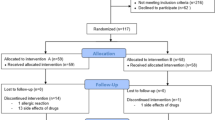Abstract
To assess efficacy and safety of lornoxicam as analgesic after surgery on head and neck in comparison to tramadol. Forty five patients undergoing operations on head and neck were recruited and randomly assigned to two parallel groups—lornoxicam and tramadol, both given intramuscular on the first post-operative day followed by oral tablets for the consecutive 4 days. Treatment was given single blind. 10 cm visual analog scale (VAS) pain score and wound tenderness assessed by a 3-point ordinal scale were the primary efficacy parameters. Use of rescue medication and percentage of subjects having at least 50 % pain relief by 48 h were also compared as secondary parameters. The groups were comparable at baseline regarding age, sex and VAS score. There was steady decline in VAS pain score from baseline to study end in both the groups, indicating good analgesic efficacy with either drug. Between groups comparisons of VAS score showed no significant difference at any time point. Between groups comparisons of wound tenderness also showed no significant difference. Five patients on lornoxicam and one patient on tramadol experienced at least 50 % pain relief at 48 hours compared to baseline while five patients from the lornoxicam group and eight from the tramadol group required rescue medicine. The tolerability of lornoxicam appeared to be significantly superior to tramadol, with less number of patients experiencing adverse drug reactions. Lornoxicam is safe, effective and comparable to tramadol for relieving postoperative pain after operations on head and neck.

Similar content being viewed by others
References
Burke A, Smyth E, Fitzgerald GA (2006). Analgesic-antipyretic agents; pharmacotherapy of gout. In: Brunton LL, Lazo JS, Parker KL (eds) Goodman & Gillman’s the pharmacological basis of therapeutics, 3rd edn. McGraw –Hill, pp 701
Sener M, Yilmazer C, Bozdogan N, Ozer C, Donmez A, Arslan G (2008) Efficacy of lornoxicam for acute postoperative pain relief after septoplasty: a comparison with diclofenac, ketoprofen and dipyrone. J Clin Anaesth 20(2):103–108
Frizziero L, Focherini MC, Valentini M, Reta M, Rocchi P (2002) Long term study on the efficacy and safety of lornoxicam in rheumatoid arthritis. Minerva Med 93(4):315–320
Ali M, Khan FA (2009) Comparison of analgesic effect of tramadol alone and a combination of tramadol and paracetamol in day-care laparoscopic surgery. Eur J Anaesthesiol 26(6):475–479
Scott LJ, Perry CM (2000) Tramadol: a review of its use in postoperative pain. Drugs 60:139–176
Vickers MD, O’ Flaherty D, Szekely SM, Read M, Yoshizumi J (2007) Tramadol: pain relief by an opioid without depression of respiration. J Assoc Anaesth Great Br Irel 47:291–296
Staunstrup H, Ovesen J, Larsen UT, Elbaek K, Larsen U, Kroner K (1999) Efficacy and tolerability of lornoxicam versus tramadol in postoperative pain. J Clin Pharmacol 39(8):834–841
Fischer S, Troidl H, MacLean AA, Koehler L, Paul A (2000) Prospective double-blind randomized study of a new regimen of pre-emptive analgesia for inguinal hernia repair: evaluation of postoperative pain score. Eur J Surg 166(7):545–551
Kelly AM (2001) The minimum clinically significant difference in visual analogue scale pain score does not differ with severity of pain. Emerg Med J 18:205–207
Gil Z, Smith DB, Marouani N, Khafif A, Fliss DM (2006) Treatment of pain after head and neck surgeries: control of acute pain after head and neck oncological surgeries. Otolaryngology–Head Neck Surg 135:182–188
Analgesics Anti-inflammatory Drugs and Antipyretics (2009) In : Sweetman SC (ed) Martindale the complete drug reference, 36th edn. Pharmaceutical Press, London pp 4
Radhofer-Welte S, Rabasseda X (2000) Lornoxicam, a new potent NSAID with an improved tolerability profile. Drugs Today 36(1):55
Skjodt NM, Davies NM (1998) Clinical pharmacokinetics of lornoxicam: a short half-life oxicam. Clin Pharmacokinet 34(6):421–428
Yakhno N, Guekht A, Skoromets A et al (2006) Analgesic efficacy and safety of lornoxicam quick-release formulation compared With diclofenac potassium. Clin Drug Investig 26(5):267–277
Narinder R, Karsten K, Marija SM, Charlotte H, Rudolf L (2010) Safety of lornoxicam in the treatment of postoperative pain: a post-marketing study of analgesic regimens containing lornoxicam compared with standard analgesic treatment in 3752 day—case surgery patients. Clin Drug Investig 30(10):687–697
Karaman S, Gunusen I, Uyar M, Firat V (2006) The effect of pre-operative lornoxicam and ketoprofen application on the morphine consumption of post-operative patient-controlled analgesia. J Int Med Res 34(2):168–175
Analgesics Anti-inflammatory Drugs and Antipyretics (2009). In: Sweetman SC (ed) Martindale the complete drug reference, 36th edn. Pharmaceutical Press, London, pp 131
Herrmann WA, Geertsen MS (2009) Efficacy and safety of lornoxicam compared with placebo and diclofenac in acute sciatica/lumbo-sciatica: an analysis from a randomised, double-blind, multicentre, parallel-group study. Int J Clin Pract 63(11):1613–1621
Norholt SE, sindet-Pedersen S, Larsen U et al (1996) Pain control after dental surgery: a double-blind, randomised trial of lornoxicam versus morphine. Pain 67:335–343
Author information
Authors and Affiliations
Corresponding author
Rights and permissions
About this article
Cite this article
Das, S.K., Banerjee, M., Mondal, S. et al. A Comparative Study of Efficacy and Safety of Lornoxicam Versus Tramadol as Analgesics After Surgery on Head and Neck. Indian J Otolaryngol Head Neck Surg 65 (Suppl 1), 126–130 (2013). https://doi.org/10.1007/s12070-013-0617-y
Received:
Accepted:
Published:
Issue Date:
DOI: https://doi.org/10.1007/s12070-013-0617-y




